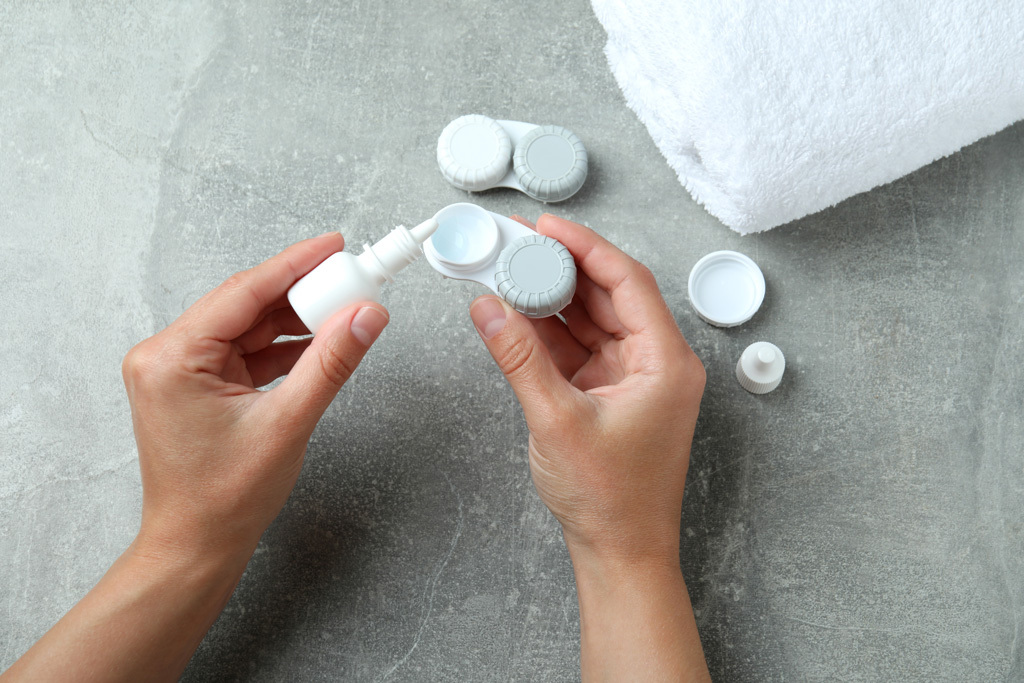Imagine waking up one morning, reaching for your contact lenses, expecting the usual crystal-clear vision. Instead, you’re met with a blurry world that leaves you squinting and stumbling. Suddenly, your routine day becomes an obstacle course.
Undoubtedly, it’s disconcerting when our trusted contacts let us down like this. After all, they are supposed to be our invisible helpers in seeing the world more clearly.
This article will explore why contact lenses sometimes turn traitors on us, causing blurry vision. We’ll also look into ways of handling dry eyes syndrome, which is common among lens wearers but often overlooked as a cause of blurriness.
Let’s talk about how to clean your contacts properly so they don’t get cloudy. Wearing glasses now and then can also help ease dryness or discomfort from ill-fitting lenses.
Table of Contents
Understanding the Causes of Blurry Contact Lenses

If your world seems a bit foggy while wearing contact lenses, don’t panic. A variety of factors may be the cause of your blurred vision while wearing contacts.
The Role of Refractive Errors
A refractive error might be to blame for your blurry vision. This is when light isn’t bent correctly as it enters the eye, causing blurred vision.
This can happen due to an irregularly shaped cornea or lens in your eye and progresses naturally with age, often requiring prescription changes.
You’re not alone if you have one – most people do. They’re so common that more than 60% of visual impairment in U.S. adults results from refractive errors, according to CDC’s Vision Health Initiative (VHI).
Underlying Eye Conditions That Cause Blurriness
An underlying eye condition may also cause blurriness when wearing contacts. For example, conditions like macular degeneration damage blood vessels, leading to hazy vision. Dry eye syndrome leads to uncomfortable wear and blurry contact lenses.
But remember, these aren’t self-diagnosable conditions; regular eye exams are crucial for early detection and management.
So the next time you notice blurry contacts or experience blurred vision with your contact lenses on, don’t just reach for another pair from your daily disposables. Instead, consider whether refractive errors or an underlying condition could play a part.
If your contact lenses need to provide the desired clarity despite proper maintenance, it may be time to explore other options.
Proper Care and Cleaning of Contact Lenses

Maintaining clear vision with your contacts is about more than just having the right prescription. It also hinges on keeping them squeaky clean.
Why, you ask? Because cloudy contacts may be screaming for a better cleaning routine. Yes, improper use can lead to deposits and blurry vision.
How Deposits on Lenses Cause Blurriness
If you’ve been lax in cleaning your contacts properly, here’s some news that might surprise you: Lens deposits are notorious party poopers.
They create a filmy layer, like peering through a foggy window. This deposit buildup blurs what should be crystal clear views of the world around us.
You wouldn’t wear dirty glasses, would you? The same principle applies to contact lenses – cleanliness equates to clarity. Not only do lens deposits cause blurred vision, but also eye irritation or infection if left unchecked – talk about an unwanted triple threat.
Avoiding Deposits on Contacts
Cleanliness is next to godliness when wearing contact lenses without hiccups (read: blur-free.). And remember, not all heroes wear capes; sometimes they come disguised as simple daily habits:
- Rinsing your lenses thoroughly before putting them in each morning.
- Storing them in fresh solution every night after removing them – no reusing old stuff.
Here’s our guide with more handy tips to ensure your hygiene game stays strong.
Tip: Try using daily disposable contacts. You can chuck them at the end of the day and start fresh in the morning – a convenient workaround for avoiding deposits altogether.
The Importance of Clean Contact Lenses
Cleaning your lenses is not just about preserving their lifespan; it’s also about safeguarding your vision and eye health.
A proper cleaning routine will keep lens-induced blurry vision at bay and free you to enjoy life’s vivid details without any foggy interruptions. After all, clear sight shouldn’t be a luxury but an everyday reality.
Dry Eyes and Its Impact on Vision Clarity with Contacts
If you’ve ever asked, “Why are my contacts blurry?” the answer could be dry eyes. Dry eye syndrome is common among contact lens wearers, often leading to blurred vision.
When your eyes aren’t producing enough tears or if they’re evaporating too quickly, this results in dry eye syndrome. This condition can make wearing contacts uncomfortable and blur your sight. The reason? Dryness affects how well the lens adheres to your eyeball’s natural shape, causing distorted images.
Dealing with Dry Contacts
Facing off against dry contacts isn’t an epic battle scene from a movie; it’s more like caring for a pet – it needs consistency and patience. First up: keep yourself hydrated. Just as water benefits our body, staying hydrated helps maintain moisture levels in our eyes.
The next step is giving artificial tears a shot. They act like real tears to lubricate your lenses and ease dryness-related blurriness.
Sometimes, though, switching up your routine might just do the trick. For instance, using daily disposable contacts instead of extended-wear ones can minimize discomfort since you put on fresh lenses daily, reducing deposits that exacerbate drying out.
If these efforts don’t relieve blurry contact lenses caused by dryness—especially if worsening or persistent—you should seek help immediately from an optometrist specializing in treating dry eye conditions.
In conclusion, the relationship between dry eyes and contact lens wear is a delicate one. Proper care of your lenses and keeping yourself hydrated are simple yet effective ways to ensure clear vision with contacts.
Ill-Fitting Contact Lenses and Vision Clarity
You’re likely unaware, but how your contact lenses fit hugely influences how sharp your vision is. Ill-fitting contacts can be more than just uncomfortable; they can cause blurry vision.
Let’s think about it like shoes. Just as wearing a pair too big or small affects how well you walk, similarly, when contacts don’t fit right, they could shift on your eyes or even get inserted incorrectly – both leading to blurriness.
How to Correctly Insert Contact Lenses
The first step towards crystal clear vision with contacts starts with knowing if your contact lens is inside out. Wearing them the wrong way around doesn’t only feel strange but also causes blurred sightlines.
Besides that, make sure the lenses are clean before popping them into your eyes because any dirt particles stuck on their surface might create cloudy visions instead of giving you the perfect 20/20 sight.
Remember that there’s no one-size-fits-all for eye care products like these, so always consult an optometrist for proper measurements and fittings based on individual needs rather than trying random ones from friends’ stash.
Adjusting to New Prescription Contacts

You’ve got your new contacts and are ready for that crystal-clear vision, right? But wait. Your eyes are telling a different story. Instead of the clarity you expected, everything looks hazy. What’s going on?
It takes time for our eyes to adjust when we get new prescription contacts. So, if things seem blurry, don’t panic – this adjustment period is entirely normal.
During your contact lens exam, your eye doctor should have told you about this possible side effect. It’s like breaking into a new pair of shoes; it might feel uncomfortable initially, but comfort will come with patience and perseverance (and maybe some artificial tears).
The Adjustment Period Explained
New lenses often mean changes in thickness or curvature compared to what your eyes were used to before. Even minor alterations can affect how light enters the eye, making refractive errors progress temporarily until they settle down.
This change can also lead to dryness, which causes additional blurriness and discomfort – a double whammy. Fortunately, solutions such as rehydrating drops help ease dry eye symptoms associated with wearing contact lenses longer than usual during the adaptation phase.
A good rule of thumb: give yourself one week per diopter difference from your old prescription glasses’ power before expecting perfect clarity from new contacts. Here’s an informative guide explaining more about this process.
If, after two weeks, your vision persists in being blurry or worsens despite proper care steps like cleaning contacts regularly and staying hydrated – it’s time to see your eye doctor. Vision changes should be communicated as soon as possible because sometimes blurry contact lenses could signal a more serious underlying condition.
Remember, no question is too silly regarding your eye health. Your doctor will help you determine if the problem persists due to adjustment issues, an infection, or ill-fitting contacts.
Recognizing Serious Eye Conditions
It is essential to be mindful that more severe eye issues, such as conjunctivitis or corneal abrasion, could also cause contact lenses to blur vision, necessitating prompt medical attention. For instance, conjunctivitis or corneal abrasion may result in blurry contacts and warrant immediate medical attention.
Symptoms of Conjunctivitis or Corneal Abrasion
A common infection that causes redness and inflammation of the tissue covering the front part of your eyes, known as pinkeye or conjunctivitis, should not be ignored if you notice a pink tint when wearing contacts; this can lead to hazy vision and requires immediate attention. Pay attention to this symptom if you notice a pink tint when wearing your contacts. This condition can make your vision hazy and should not be taken lightly.
A corneal abrasion, on the other hand, is a scratch on your eye’s surface that could occur due to the wrong handling of contact lenses. Such an injury may give rise to symptoms like pain, light sensitivity, and blurry vision – signs that call for quick action.
If these problems persist even after removing your contact lens, it might signal something serious needing professional help.
An unexpected change in sight while wearing glasses instead of contacts must also ring alarm bells because it points toward an underlying issue rather than a lens problem. A doctor can use specific tests during eye exams, such as an optic nerve assessment, to evaluate for any possible illnesses causing harm to the blood vessels near the eyes, e.g., diabetic retinopathy.
In some cases, though, seeing halos around objects doesn’t always mean there’s cause for concern. But, if you notice rainbow lights, it could indicate corneal edema – a medical condition where the cornea swells up due to fluid buildup.
Remember that these symptoms are not exhaustive, and other eye infections might result in blurry vision. It’s essential always to seek medical advice when your contacts feel uncomfortable or your sight isn’t crystal clear.
Maintaining Clear Vision with Contact Lenses
Having clear vision is a top priority for all contact lens wearers. However, sometimes, deposits on your lenses can cause blurriness and even lead to infections. But don’t worry. We have some handy tips to help you maintain that crystal-clear vision.
Addressing Lens Movement
Contact lenses might shift from time to time, resulting in blurry sightlines. This typically happens if the contacts do not fit properly or are worn out.
Regular eye exams should be undertaken to ensure your contacts are properly fitted and your prescription is current. Regular check-ups will also allow early detection of potential eye conditions affecting your ability to wear contacts comfortably.
Avoid wearing contact lenses longer than your doctor recommends; overuse could make them dry and more prone to movement. Instead, consider regularly using daily disposables or cleaning contacts with proper solutions for optimal hydration.
Easing Dry Eyes
- Dry eyes often plague those who wear contacts – particularly in air-conditioned environments or towards the end of a long day.
- But fear not. A simple solution to ease dry eyes is using eye drops designed for contact lens wearers. These ‘artificial tears’ keep your lenses moist and help you maintain clear vision throughout the day.
If the issue keeps popping up, you might want to think about sporting glasses now and then. Take a break and give your peepers some relief. Remember, nothing should stand in the path of your clear sight.
FAQs About Blurry Contact Lenses
Why do my contact lenses feel blurry?
Your contacts might be dirty, dry, or damaged. Also, an outdated prescription could cause blurriness.
Why do my contact lenses get foggy?
Foggy contacts usually come from protein deposits or environmental irritants. A good cleaning should clear them up.
How do you fix dry, blurry contacts?
To fix dry and blurry contacts, use a quality lens solution to hydrate them again. If the problem persists, see your eye doctor.
Why do my eyes feel strained when I wear contacts but not glasses?
If wearing contacts strains your eyes more than glasses, it’s likely because of poor fit or an incorrect prescription. Visit your optometrist for a check-up if this continues.
So, you’ve learned why your contact lenses might be getting blurry. You’ve understood the role of refractive errors and underlying eye conditions in causing blurriness.
You’re now aware of how improper care can lead to deposits on lenses, which blur your vision. Dry eye syndrome isn’t a stranger; it’s common among lens wearers and often overlooked as a cause of blurry vision.
We also touched upon ill-fitting contacts that result in hazy vision and how an adjustment period is required when using new prescription glasses.
The scary part – recognizing serious eye infections like conjunctivitis or corneal abrasion was not missed either! Finally, we shared some handy tips for maintaining clear vision with contact lenses by addressing issues like dryness, deposits, and lens movement.
In conclusion, keep those peepers clean, stay hydrated if wearing contacts longer than usual is needed, and don’t hesitate to see an eye doctor if any problem persists!

